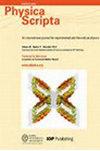Multi-polarized four-mode wideband vortex electromagnetic beams generation through reflective metasurface in Ka-band
IF 2.6
3区 物理与天体物理
Q2 PHYSICS, MULTIDISCIPLINARY
引用次数: 0
Abstract
Orbital angular momentum (OAM) is a new dimension for improving channel capacity and has been widely studied by scientists. In recent years, there has been an increasing amount of research on antennas and electromagnetic (EM) beams containing OAM, demonstrating its excellent ability in communication. This article proposes a Ka-band multi-mode orbital angular momentum reflectarray antenna (RA) capable of generating four vortex EM beams with four modes (l = −1, 0, +1, +2). The proposed unit cell can cover a 360-degree reflection phase range with a magnitude above 0.88, achieved through a combination of variable-sized and delay-line units. Furthermore, the unit cell’s mirror configuration allows for cross-polarization rejection. Based on these unit cells, a square reflectarray antenna (25 × 25 elements) is designed, fabricated, and measured. The measured results demonstrate that the 1 dB bandwidths for four modes are 25.81% (27–35 GHz, l = −1), 31.25% (27–37 GHz, l = 0), 28.57% (27–36 GHz, l = +1), and 20.69% (26–32 GHz, l = +2), respectively. Notably, the 3 dB gain bandwidths of all modes exceed 40%, with the maximum 3 dB bandwidth reaching 47.62% at mode l = +1. Furthermore, all vortex EM beams of this proposed RA maintain mode purities exceeding 70% within 3 dB bandwidths.通过 Ka 波段反射元面产生多极化四模宽带涡旋电磁波束
轨道角动量(OAM)是提高信道容量的一个新维度,已被科学家广泛研究。近年来,对含有轨道角动量的天线和电磁(EM)波束的研究日益增多,显示了其在通信中的卓越能力。本文提出了一种 Ka 波段多模轨道角动量反射阵列天线(RA),能够产生四种模式(l = -1、0、+1、+2)的涡旋电磁波束。通过可变尺寸单元和延迟线单元的组合,拟议的单元可覆盖 360 度的反射相位范围,幅度超过 0.88。此外,该单元的镜面配置还可实现跨偏振抑制。基于这些单元,设计、制造并测量了一个方形反射阵列天线(25 × 25 个元件)。测量结果表明,四种模式的 1 dB 带宽分别为 25.81% (27-35 GHz, l = -1), 31.25% (27-37 GHz, l = 0), 28.57% (27-36 GHz, l = +1) 和 20.69% (26-32 GHz, l = +2)。值得注意的是,所有模式的 3 dB 增益带宽都超过了 40%,模式 l = +1 时的最大 3 dB 带宽达到了 47.62%。此外,该拟议 RA 的所有涡旋电磁波束都能在 3 dB 带宽内保持超过 70% 的模式纯度。
本文章由计算机程序翻译,如有差异,请以英文原文为准。
求助全文
约1分钟内获得全文
求助全文
来源期刊

Physica Scripta
物理-物理:综合
CiteScore
3.70
自引率
3.40%
发文量
782
审稿时长
4.5 months
期刊介绍:
Physica Scripta is an international journal for original research in any branch of experimental and theoretical physics. Articles will be considered in any of the following topics, and interdisciplinary topics involving physics are also welcomed:
-Atomic, molecular and optical physics-
Plasma physics-
Condensed matter physics-
Mathematical physics-
Astrophysics-
High energy physics-
Nuclear physics-
Nonlinear physics.
The journal aims to increase the visibility and accessibility of research to the wider physical sciences community. Articles on topics of broad interest are encouraged and submissions in more specialist fields should endeavour to include reference to the wider context of their research in the introduction.
 求助内容:
求助内容: 应助结果提醒方式:
应助结果提醒方式:


